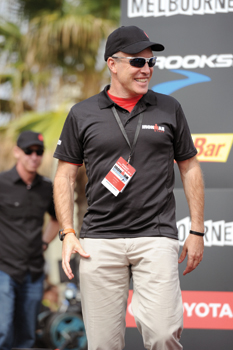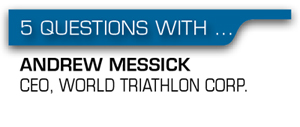It’s been one year since Andrew Messick stepped down as president of AEG Sports to take over as CEO of the World Triathlon Corp., owner of the popular Ironman brand of races. Messick came to the WTC having overseen the Amgen Tour of California, the country’s biggest professional bicycle race. So far, Messick has had a busy year. The WTC expanded with eight new races in 2012, including this month’s Ironman U.S. Championship in New York City.
Correspondent Fred Dreier caught up with Messick at New York’s inaugural Ironman race to talk about the sport’s growth.
■ Having spent one year in triathlon now, how does the business culture here differ from cycling?
 |
Messick and the World Triathlon Corp. have added eight new races for 2012.
Photo by: FINISHERPIX.COM |
MESSICK: It’s totally different. The business of cycling is about sponsorship, endorsements and media, whereas the business of triathlon is all about athlete registration fees from an event. For cycling, you need to build an online or a broad-based TV platform, otherwise you simply won’t get sponsors to sign up. Fans don’t pay anything to watch, and there is no way to sell tickets to a bike race. Here, the bread and butter is the age-group athletes.
■ Ironman has long relied on NBC’s two-hour recap show of the Hawaii Ironman to bring in broader viewership. Are you pushing to get more network TV coverage?
MESSICK: NBC has been a fantastic partner, and we’re with them through 2018. We’re also really sensitive to the way people now consume media. A recap show that occurs four weeks after the fact serves a great end from a storytelling aspect, but in terms of a compelling sports product, it’s more important that we are live. We tell that story at Ironmanlive.com right now, but at some point we have to make a decision about how we want our followers to consume our product. Do we want to be online or handheld? Either way, NBC and that type of high production value is going to be part of our future for a long time.
■ What challenges do you face in selling Ironman to marketers?
MESSICK: There is a perception that is starting to ebb that our sport is super niche — that the ability to swim 2.4 miles, bike 112 and run a marathon is only for extraordinary people. The professionals are extraordinary, but part of the power of our brand is that anybody can do it. You don’t have to be a member of the lucky gene club to be an Ironman. You need commitment and the ability to dream big, but if you look at the people coming across the finish line, you will see all shapes and sizes. That perception isn’t as broadly held as we’d like it to be, and it’s going to be our challenge in the coming years.
■ What categories are you going to be targeting for sponsorship in the immediate future?
MESSICK: We’re going to focus on health care, telecommunications, airlines and the types of companies that deal with our types of athletes — a super-educated, super-motivated athlete with a household income of $175,000 who is deeply engaged in sport. Sure, our demo is good, but if you’re signed up for one of our races, you spend all year thinking about what products you’re going to use for training, where you’re going to go for a training camp, what types of equipment you will use. What makes an Ironman sponsorship platform attractive is the depth of commitment our athletes have.
■ So the Ironman brand has been around 35 years, there are 30 global Ironman races and even more 70.3 (half Ironman) races. At what point do you start worrying about saturation?
MESSICK: We don’t have a race in Eastern Europe. We don’t have one in the Middle East. We only have one full Ironman in South America and not a full [one] on continental Asia. There were 56 athletes from Japan [at the world championships] in Kona last year and Japan doesn’t have a full Ironman. When we think about all of the places we are not, we see the potential. Putting a race in a city grows that market, and that’s what we hope happens in New York. We had 66,000 athletes sign up for an Ironman last year. That’s not that many. By and large all of our races in North America are sold out, so I don’t think saturation is a big issue for us.
Fred Dreier is a writer in New York.





